Specialized Turbo Levo Comp Alloy
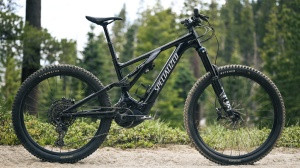 Specialized Turbo Levo Comp Alloy e-mountain bike on a trail
Specialized Turbo Levo Comp Alloy e-mountain bike on a trail
87
OVERALL SCORE
- Downhill Performance 9.0
- Climbing Performance 8.0
- Measured Effective Range 9.0
- Power Output 9.0
- E-Bike Controls 7.0
REASONS TO BUY
- Long-lasting 700Wh battery for extended rides
- Highly adjustable geometry to customize ride feel
- Intuitive and user-friendly operation
- Excellent range for all-day adventures
REASONS TO AVOID
- Stock tires could benefit from tougher casings for aggressive riding
- Fork is not e-bike specific, potentially limiting performance in demanding situations
- Brakes (SRAM Code R) may feel underpowered on long, steep descents
- Battery capacity, while good, is no longer leading the market
SPECIFICATIONS
| Wheel size (inches) | MX (29″ front, 27.5″ rear) |
|---|---|
| Battery Size (Wh) | 700Wh |
| Motor System | Specialized Turbo Full Power 2.2 |
| Motor Power (torque) | 90Nm |
| Measured Weight (w/o pedals) | 51 lbs 3 oz (S4) |
The Specialized Turbo Levo Comp Alloy continues its reign as our top pick for the fourth consecutive year. Our lead tester, Joshua Hutchens, sums it up best: “It’s just the most fun to ride.” A standout feature is its adjustable geometry, offering six distinct configurations through headset cups and chainstay flip chips. The head tube angle can be altered from 65.5 to 63.5 degrees in full-degree increments, while the bottom bracket height adjusts by 7mm. Joshua highlights, “This unprecedented adjustability allows riders to tailor the bike to their specific riding style, terrain, and preferences, elevating the Levo’s versatility significantly.”
The move to mixed wheel sizes enhances maneuverability in the rear and provides better clearance on steep trails. The 700Wh battery delivers an impressive 33.1-mile range in our tests, surpassed only by the Canyon Spectral:ON CF 8 with its larger 900Wh battery. The motor provides substantial torque with customizable support settings. The system’s refinement and integration are top-notch. The Comp Alloy model offers a functional and capable component package, providing excellent value, especially with current discounts bringing the price down. While the Ari Wire Peak 2.0 Comp is more affordable, it compromises significantly on performance.
Despite its many positives, the Turbo Levo Comp isn’t without minor drawbacks. A handlebar display might be a welcome addition, although the top tube TCU provides essential data while maintaining a clean cockpit. The SRAM Code R brakes on our test bike were adequate but exhibited a spongy feel during extended descents due to heat build-up. While we appreciate Specialized tires, the GRID Trail casings aren’t ideal for the bike’s weight and aggressive riding potential. Nevertheless, the Specialized remains a test team favorite, praised for its adjustable geometry, well-rounded performance, and impressive range and efficiency. Many of our testers, owning various Levo models, attest to its incredible value. While motor replacements have occurred, the warranty process has been consistently positive.
Read more: Specialized Turbo Levo Comp Alloy review
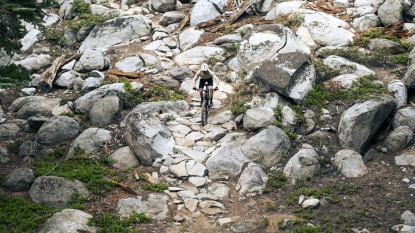 Rider testing Specialized Turbo Levo Comp Alloy e-mountain bike in the mountains
Rider testing Specialized Turbo Levo Comp Alloy e-mountain bike in the mountains
Image: Rider enjoying downhill on Specialized Turbo Levo Comp Alloy, a top-rated e-mountain bike.
Best E-MTB for Range
Canyon Spectral:ON CF 8
85
OVERALL SCORE
- Downhill Performance 8.0
- Climbing Performance 8.0
- Measured Effective Range 10.0
- Power Output 8.0
- E-Bike Controls 8.0
REASONS TO BUY
- Very competitive pricing for its features
- High-quality component build
- Lightweight carbon frame
- Well-balanced and versatile performance
- Massive battery capacity for exceptional range
REASONS TO AVOID
- Reduced ground clearance due to motor/battery housing
- Fork is not e-bike specific and can feel flexy
- Stock tires should have more robust casings for demanding trails
SPECIFICATIONS
| Wheel size (inches) | MX (29″ front, 27.5″ rear) |
|---|---|
| Battery Size (Wh) | 900Wh |
| Motor System | Shimano EP8 |
| Motor Power (torque) | 85Nm |
| Measured Weight (w/o pedals) | 51 lbs 15 oz (Large) |
The Canyon Spectral:ON CF 8 impressed us with its massive 900Wh battery, setting a new benchmark for range in our tests. Featuring mixed wheel sizes, 155/150mm of travel, and a modern trail geometry, this full carbon frame e-MTB is designed for serious adventures. Chris McNamara noted, “I could ride nearly 10,000 vertical feet in eco mode, well beyond any E-MTB I have tested.” The Shimano EP8 motor is strategically angled to accommodate the large battery and maintain a low center of gravity. The result is a surprisingly maneuverable and balanced bike, defying its heavier weight. It provides stable handling and ample travel for challenging terrain while remaining agile on mellower trails. Its trail geometry strikes a balance between climbing efficiency, agility, and overall versatility. Canyon’s direct-to-consumer model allows them to offer this bike at a highly competitive price, making it an exceptional value proposition for a carbon e-MTB with this spec and battery size.
The Spectral:ON CF 8 isn’t perfect. The large 900Wh battery, while a major selling point, results in a bulge below the bottom bracket, reducing ground clearance, especially with the already low bottom bracket height. While the Fox 36 Rhythm fork is generally capable, the bike’s weight could be better supported by a burlier Fox 38. We experienced some flex in the 36 fork under hard braking and in rough terrain. The Maxxis Minion DHR II and Assegai tire combo is excellent, but the EXO+ and EXO casings are not robust enough for the Spectral:ON’s weight and aggressive riding capabilities. Upgrading tires is a relatively inexpensive fix, but premature tire or rim damage is disappointing. Despite these minor drawbacks, the Spectral:ON CF 8 is a top contender in the electric mountain bike market, particularly for riders prioritizing range and value.
Read more: Canyon Spectral:ON CF 8 review
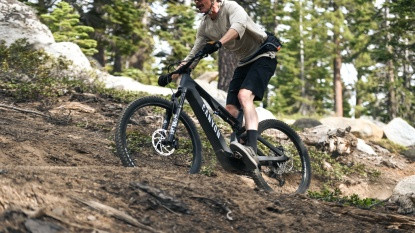 Rider on Canyon Spectral:ON CF 8 e-mountain bike with long battery range
Rider on Canyon Spectral:ON CF 8 e-mountain bike with long battery range
Image: Canyon Spectral:ON CF 8 e-mountain bike with large battery capacity for extended range.
Best Value E-Mountain Bike
Aventon Ramblas
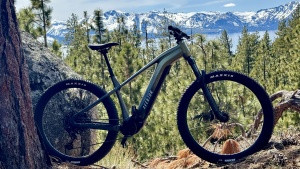 Aventon Ramblas e-mountain bike on a dirt trail
Aventon Ramblas e-mountain bike on a dirt trail
80
OVERALL SCORE
- Downhill Performance 7.0
- Climbing Performance 7.0
- Measured Effective Range 9.0
- Power Output 10.0
- E-Bike Controls 8.0
REASONS TO BUY
- Exceptional value for money in the e-MTB category
- Impressive battery range for extended trail exploration
- Incredibly powerful motor for tackling steep climbs
REASONS TO AVOID
- Relatively heavy compared to other e-MTBs
- Non-adjustable fork limits customization
- Integrated tail lights may be an unusual feature for some mountain bikers
SPECIFICATIONS
| Wheel size (inches) | 29 |
|---|---|
| Battery Size (Wh) | 708Wh |
| Motor System | Aventon A100 |
| Motor Power (torque) | 100Nm |
| Measured Weight (w/o pedals) | 54 lbs (Large) |
Aventon, primarily known for urban and commuter bikes, enters the e-mountain bike arena with the Ramblas, powered by their new A100 motor. The Ramblas delivers an exciting package at a groundbreaking price point. Its component spec includes a RockShox 35 Silver fork, SRAM NX Eagle drivetrain, SRAM DB8 brakes, a dropper post, and Maxxis tires—components typically found on much pricier bikes. A removable 708Wh battery powers the high-torque motor. This is the most affordable full-suspension e-MTB we’ve tested, and remarkably, also the most powerful, registering over 26Nm of torque at the rear wheel in our dynamometer tests. Lead tester Joshua states, “Most E-MTB models climb at about the same rate in turbo. The Ramblas just smoked them all.”
The aluminum frame, 29″ wheels, 130mm coil-sprung fork, and slightly conservative modern geometry contribute to the Ramblas’ versatility. Its impressive spec and performance make it more than just the sum of its parts. It’s incredibly fun and powerful, often outperforming other e-bikes in cross-country scenarios. Aventon’s direct-to-consumer model translates to significant cost savings. With four frame sizes, including a small size with 27.5″ wheels, the Ramblas caters to a broad range of riders.
However, the Ramblas ride quality is less refined. The non-adjustable fork and non-tubeless compatible rims compromise comfort, potentially deterring aggressive trail riders. Its versatility extends beyond trails, though. Equipped with integrated tail lights, a bright headlight, and kickstand mount points, it appeals to riders seeking a versatile e-bike with a mountain bike disposition for varied uses. Weighing in at 54 lbs, it’s not light, but the powerful motor compensates for the weight. In our range test, the Ramblas covered 30.1 miles with nearly 6,000 feet of climbing on a single charge. Powerful, capable, and exceptionally priced, the Ramblas is a standout value in the e-MTB market.
Read more: Aventon Ramblas review
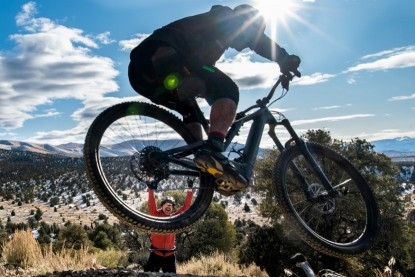 Aventon Ramblas e-mountain bike offers great value and power
Aventon Ramblas e-mountain bike offers great value and power
Image: Aventon Ramblas e-mountain bike, a top value option with impressive performance and features.
Best Lightweight E-Mountain Bike
Specialized Turbo Levo SL Comp
76
OVERALL SCORE
- Downhill Performance 9.0
- Climbing Performance 8.0
- Measured Effective Range 6.0
- Power Output 6.0
- E-Bike Controls 10.0
REASONS TO BUY
- Trail bike-like ride quality and handling
- Excellent system integration for a clean look
- Lightweight design enhances agility
- Optional range extender battery for longer rides
REASONS TO AVOID
- Higher price point compared to full-power e-MTBs
SPECIFICATIONS
| Wheel size (inches) | MX (29″ front, 27.5″ rear) |
|---|---|
| Battery Size (Wh) | 320Wh (+160Wh Range Extender) |
| Motor System | Specialized SL 1.2 (320W) |
| Motor Power (torque) | 50Nm |
| Measured Weight (w/o pedals) | 40 lbs 1 oz (S4)(2lbs 6 oz – range extender battery) |
The redesigned Specialized Turbo Levo SL Comp redefines the lightweight e-MTB category. Built around Specialized’s SL 1.2 motor and a 320Wh battery, it offers a more natural riding experience, blending the feel of a traditional trail bike with electric assist. Its 50Nm motor delivers less torque than the standard Levo’s 90Nm, focusing instead on subtle assistance and reduced weight. At just over 40 pounds, it’s significantly lighter than competitors like the Trek Fuel EXe 8 GX AXS Transmission, making it a prime option for riders considering mid-power e-MTBs. The Levo SL stands out with its lighter weight, exceptional adjustability, and user-friendly interface.
Its downhill performance is impressive; the adjustable headtube angle enhances high-speed stability, and the short 432mm chainstays contribute to its playful, agile feel. The lighter weight makes it sprightly in technical terrain, unlike heavier e-MTBs. Power delivery is natural, enhancing the rider’s input without overpowering the experience, allowing for a more athletic climbing feel. While its power output test results are lower, this is intentional, providing assist while still demanding rider engagement.
The FACT 11M carbon frame and Fox suspension offer a comfortable and responsive ride. The SRAM drivetrain provides reliable performance. While the higher-end Transmission drivetrain offers more precision, the cost increase isn’t necessarily justified. This build represents a performance sweet spot for the price. Specialized also offers an alloy version, but the weight savings of the carbon model are significant for the minimal price difference. We also tested it with a 29″ rear wheel, which improved efficiency but reduced some of its playful character. Testers appreciated the bike’s lightweight feel, even riding it without power and still enjoying a great trail experience.
Read more: Specialized Turbo Levo SL Comp review
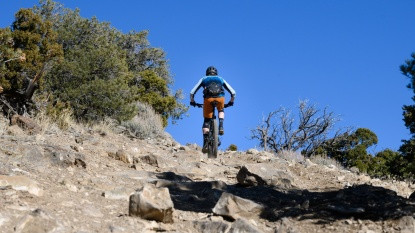 Specialized Turbo Levo SL Comp lightweight e-mountain bike on trail
Specialized Turbo Levo SL Comp lightweight e-mountain bike on trail
Image: Specialized Turbo Levo SL Comp, a lightweight e-mountain bike offering a trail bike feel with motor assist.
E-Mountain Bike Comparison
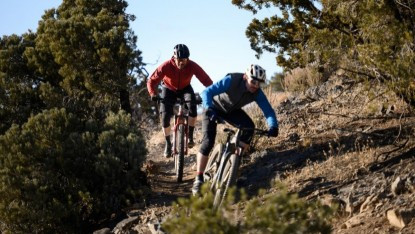 Group of e-mountain bikers testing new models on a trail
Group of e-mountain bikers testing new models on a trail
Image: Group of riders testing and comparing the best new electric mountain bikes.
How We Test E-Mountain Bikes
Our team of experienced mountain bike testers rigorously evaluates each electric mountain bike over several months across diverse trails and climates. Each bike is ridden extensively, often back-to-back with other models for direct comparison. We push these bikes to their limits to identify strengths and weaknesses in real-world conditions.
Our testing protocol focuses on five key metrics:
- Downhill Performance (30% of overall score)
- Climbing Performance (25% of overall score)
- Distance Range (25% of overall score)
- Power Output (15% of overall score)
- E-Bike Controls (5% of overall score)
This multi-point performance analysis ranks each bike based on its merits as both a mountain bike and an e-bike. Hundreds of miles are logged on each model, subjecting them to numerous tests to assess and compare performance. Downhill performance carries the highest weight (30%) as it is considered the most critical aspect of a mountain bike’s functionality.
Why Trust GearLab for E-MTB Reviews
Our testing team comprises seasoned bike industry professionals: racers, mechanics, shop owners, and passionate cycling enthusiasts.
Joshua Hutchens brings decades of experience as a racer, bike shop owner, mechanic, and guide. He also teaches mountain biking. Joshua possesses a keen eye for mountain bike performance nuances and excels in evaluating bikes’ handling and capabilities.
Jeremy Benson, a lifelong mountain biker since 1992 and racer since 1999, has deep expertise in mountain biking. He authored Mountain Bike Tahoe and continues to race and achieve impressive results.
Kurt Gensheimer is a veteran bike industry writer with decades of bike testing experience, specializing in exploring remote areas on e-mountain bikes.
Chris McNamara, a rock climber turned avid mountain biker, excels in endurance rides and is pursuing ambitious long-distance singletrack routes.
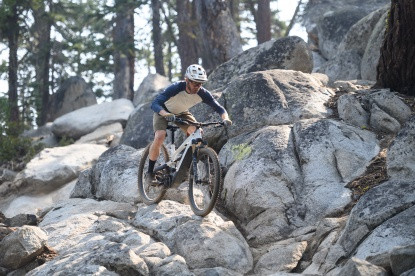 E-mountain bike testing near Lake Tahoe, California
E-mountain bike testing near Lake Tahoe, California
Image: E-mountain bike testing on moto-legal trails near Lake Tahoe, CA, ensuring rigorous real-world evaluation.
Choosing the Best Electric Mountain Bike: A Buyer’s Guide
Selecting the ideal e-mountain bike can be challenging. Adding a motor introduces more complexity. This guide highlights key considerations to simplify your buying process.
Full Power vs. Lightweight E-MTB
Full-power e-MTBs feature larger motors (700-900Wh range, 80-90Nm torque) and are ideal for long rides, steep climbs, or riders seeking maximum assistance.
Lightweight e-MTBs offer subtle pedal assist with smaller batteries (320-430Wh), prioritizing handling and agility. Their streamlined design resembles acoustic bikes, delivering a more natural ride feel.
Consider your riding style and needs. Do you prioritize maximum range and power for challenging terrain, or a more natural, agile ride? Your typical riding habits and trails will guide your choice.
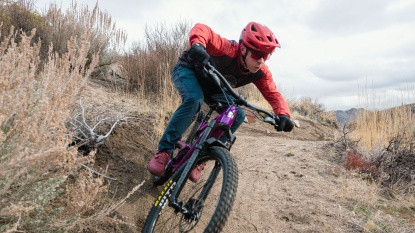 Choosing between lightweight and full-power e-mountain bikes
Choosing between lightweight and full-power e-mountain bikes
Image: Comparing lightweight vs full-power e-mountain bikes to determine the best type for your riding style.
Frame Material: Alloy vs. Carbon
Like traditional mountain bikes, e-MTBs come in alloy and carbon frames. Carbon frames offer lighter weight and vibration damping, crucial for e-MTBs. Carbon reduces significant weight in the downtube and motor area. However, carbon frames are more expensive. For weight-conscious riders, carbon is worthwhile. For others, alloy is more affordable and durable against scratches and scrapes.
Wheel Size: 29″ vs. Mixed (Mullet)
Most e-MTBs use 29″ wheels for stability and rollover capability. Some opt for “mullet” setups (29″ front, 27.5″ rear). Wheel size choice depends on the bike model, as not all offer both options. Some bikes feature flip chips to accommodate different rear wheel sizes. Mullet setups enhance agility and playfulness due to shorter chainstays. Decide based on preference: stability and rollover (29″) vs. maneuverability (mullet).
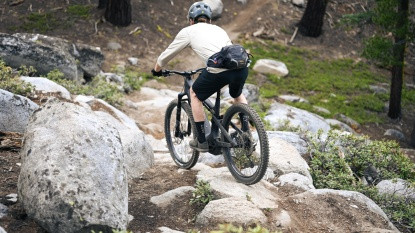 Choosing the right wheel size for your e-mountain bike
Choosing the right wheel size for your e-mountain bike
Image: Selecting the right e-mountain bike wheel size for your riding style: 29er for stability or mullet for agility.
Suspension Travel: How Much Do You Need?
Suspension travel defines a bike’s riding capabilities. Under 140mm travel is ideal for cross-country and trail riding. 140-160mm is the most popular for e-MTBs, offering a balance. Over 160mm is for downhill-focused riding. Most e-MTBs fall into the all-mountain category (140-160mm), balancing uphill and downhill performance. Well-designed e-MTBs can handle more travel without compromising uphill efficiency due to motor assist.
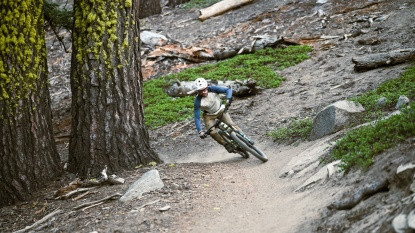 Selecting the right suspension travel for your e-mountain bike
Selecting the right suspension travel for your e-mountain bike
Image: Choosing appropriate suspension travel for your e-mountain bike based on terrain and riding preferences.
E-Mountain Bike Analysis and Test Results
We rigorously analyzed each e-bike’s performance across key metrics: downhill, climbing, range, power, and controls. This provides the knowledge needed for your e-bike buying quest.
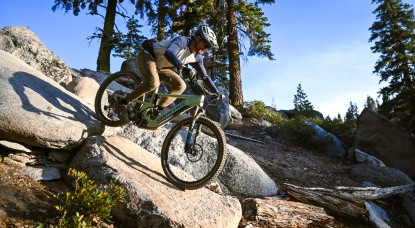 E-mountain bike testing limits and performance
E-mountain bike testing limits and performance
Image: Pushing e-mountain bikes to their limits during testing to evaluate handling and performance differences.
Best Value E-MTB Options
E-mountain bikes can be expensive. Higher-performing models are often pricier, but exceptions exist. The Aventon Ramblas offers exceptional performance at a lower price through direct-to-consumer sales. Similarly, the YT Decoy 29 Core 4 and Canyon Spectral:ON CF8, while not cheap, offer carbon frames and excellent performance at a fraction of the cost of comparable bikes from larger brands.
 Aventon Ramblas e-mountain bike offers great value and power
Aventon Ramblas e-mountain bike offers great value and power
Image: Sharing the fun and excitement of e-bike testing and riding.
Understanding E-Bike Classifications
Electric bikes vary in classifications. Most e-MTBs are Class 1: pedal-assist only, with power delivered while pedaling, limited to 20 mph in the US. These resemble mountain bikes but integrate batteries and motors. The motor, usually near the bottom bracket, provides pedal support in varying degrees. Most systems offer customizable support settings.
We tested full-suspension all-mountain/trail models with similar travel, geometry, and wheel/tire sizes. E-bikes are heavier (around 50 lbs, ~20 lbs heavier than non-e-bikes) due to batteries and motors, making them harder to ride without assist. The Trek Fuel EXe, a lighter model, weighs just over 45 lbs.
E-MTBs are legal in many US areas, especially on motorized trails. Always check local regulations before riding. We tested on OHV trails near Lake Tahoe, where e-MTBs are permitted.
E-bikes have more components prone to failure (motor, battery, controls, wiring). Research warranties and buy from local dealers for support.
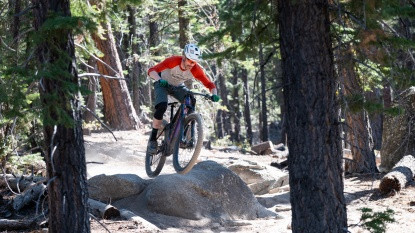 Modern e-mountain bikes excel on descents
Modern e-mountain bikes excel on descents
Image: Modern electric mountain bikes like Trek Rail 9.7 demonstrate excellent downhill performance.
Downhill Performance Analysis
Downhill performance is our highest-weighted metric. We tested each bike extensively downhill across varied terrains.
The Trek Fuel EXe was a tester favorite, feeling like a “regular trail bike” downhill. Its lighter weight makes it nimble and agile, yet stable. The Turbo Levo Comp was another top performer, with balanced weight, responsive handling, and adjustable geometry for customized riding.
The Santa Cruz Heckler SL is versatile and lightweight, performing well across speeds and terrains. The Canyon Spectral:ON CF 8 is surprisingly nimble for its weight and inspires confidence at high speeds.
The YT Decoy 29 impressed with versatility and well-rounded downhill performance, feeling like a responsive trail bike. The Commencal Meta Power TR Ride excels in speed and rowdy terrain, yet remains fun on flow trails. The Trek Rail 9.7 offers a damp, ground-hugging feel and adjustable geometry.
 Rider testing Specialized Turbo Levo Comp Alloy e-mountain bike in the mountains
Rider testing Specialized Turbo Levo Comp Alloy e-mountain bike in the mountains
Image: Turbo Levo Comp’s adjustable geometry allows for personalized ride characteristics and handling.
 YT Decoy 29 versatile downhill e-mountain bike
YT Decoy 29 versatile downhill e-mountain bike
Image: YT Decoy 29 is a versatile e-mountain bike excelling in downhill performance and varied terrain.
Climbing Performance Evaluation
E-bikes make climbing easier and even enjoyable. Climbing dynamics differ from non-motorized bikes, with faster uphill speeds and emphasis on power and momentum. E-bike weight provides traction, and suspension can remain active for added grip.
The YT Decoy 29 Core 4 excels in climbing with its powerful Shimano EP8 motor and trail geometry. The Specialized Turbo Levo Comp is another top climber, with a refined motor and maneuverable geometry.
The Canyon Spectral:ON CF 8 climbs well with its EP8 motor and trail geometry. The YT Decoy shares the same motor and climbs effectively with its suspension design.
The Trek Fuel Exe and Specialized Levo SL are agile climbers, requiring more line precision than full-power models. Their flip chips allow geometry adjustments for climbing optimization. The Santa Cruz Heckler SL requires more rider effort on climbs due to lower power output, but offers comfortable geometry and efficient drivetrain.
 Trek Rail e-mountain bike climbing ability
Trek Rail e-mountain bike climbing ability
Image: Trek Rail e-mountain bike demonstrating capable climbing performance over varied terrain.
 Specialized Turbo Levo SL Comp lightweight e-mountain bike on trail
Specialized Turbo Levo SL Comp lightweight e-mountain bike on trail
Image: Turbo Levo SL e-mountain bike showcasing lightweight and efficient climbing capabilities.
Distance Range Testing
E-bike range is the distance achievable on a single charge. Battery capacities vary (625-700Wh, some 900Wh). Larger batteries theoretically offer longer range, but factors like rider weight, terrain, and temperature affect it.
We tested range by having a tester ride each bike in its highest support setting on a consistent course until battery depletion, recording distance and vertical gain.
The Canyon Spectral:ON CF 8, with its 900Wh battery, had the longest range, covering 38.5 miles with 5,292 feet of elevation change. The Turbo Levo Comp with a 700Wh battery performed well, achieving 33.1 miles and 5,000 vertical feet.
The Commencal Meta Power TR (630Wh battery) achieved over 26 miles. The Trek Rail 9.7 (625Wh battery) impressed with 28.95 miles. The Aventon Ramblas (708Wh) reached 30.1 miles. The YT Decoy 29 Core 4 (540Wh) achieved 23.2 miles.
The Trek Fuel EXe (360Wh) had the shortest range at 19 miles but can achieve longer ranges in Eco mode. Lower power output settings extend range. Smartphone apps allow customization of support settings and range optimization.
 Rider on Canyon Spectral:ON CF 8 e-mountain bike with long battery range
Rider on Canyon Spectral:ON CF 8 e-mountain bike with long battery range
Image: Canyon Spectral:ON CF 8 e-mountain bike featuring a 900Wh battery for maximum range.
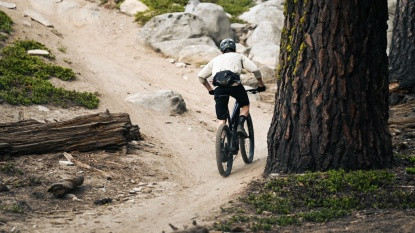 Turbo Levo Comp battery range for long rides
Turbo Levo Comp battery range for long rides
Image: Turbo Levo Comp e-mountain bike with a 700Wh battery, suitable for extended mountain rides.
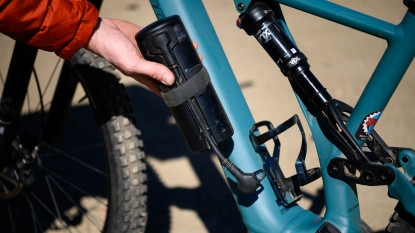 Levo SL range extender battery
Levo SL range extender battery
Image: Levo SL’s range extender battery option for increasing ride distance and battery capacity.
Power Output Assessment
E-bike motors assist pedaling. Systems function similarly, but power output differences create distinct feels. All tested bikes are Class 1 (20 mph limit) with varying support modes.
The Specialized 2.2 motor (90Nm torque, 565W peak) felt slightly more powerful, except compared to the Aventon Ramblas with its A100 motor (100Nm torque). The Bosch Performance CX motor on the Trek Rail 9.7 (85Nm torque) felt very powerful. Shimano EP8 motors (Commencal, Canyon, YT) (85Nm) offer smooth, strong power but slightly less than Bosch.
The Trek Fuel EXe with the TQ HPR-50 motor (50Nm, 300W) has less power, intentionally requiring more rider effort. The Santa Cruz Heckler SL with the Fazua Ride60 motor (60Nm) felt less punchy than the Trek’s motor.
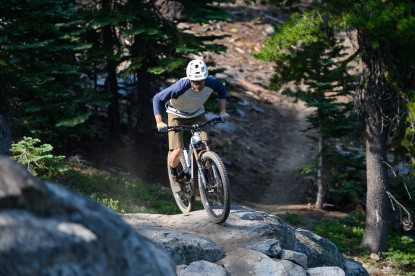 Shimano EP8 motor on e-mountain bike
Shimano EP8 motor on e-mountain bike
Image: Shimano EP8 motor on Decoy 29, providing reliable and powerful assist for e-mountain biking.
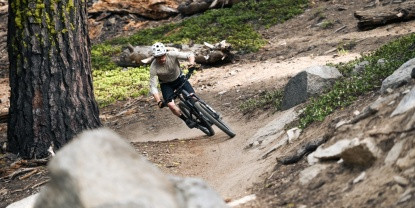 Shimano EP8 motor on Canyon e-mountain bike
Shimano EP8 motor on Canyon e-mountain bike
Image: Shimano’s EP8 motor, used in Canyon, YT, Santa Cruz, and Commencal e-mountain bikes, offering strong trail performance.
E-Bike Controls and User Interface
E-bike controls and user interface are important for usability. We evaluated user-friendliness, shifter ergonomics, display readability, and charging ease. Smartphone apps offer customization but are not essential.
The Commencal Meta Power TR Team scored well with its handlebar display and ergonomic Shimano controls. The YT Decoy 29 and Canyon Spectral:ON CF 8 have similar Shimano controls and displays, but the E7000 display lacks color-coding. Customization is available via the Shimano e-Tube app.
The Trek Rail 9.7 features a Bosch Kiox display and controls. Controls are intuitive, but ergonomics are less ideal. The top tube display is visually appealing but less practical while riding. The Specialized Turbo Levo Comp scores lower due to the lack of handlebar display. Its top tube LED display is less readable while riding, though functional. Newer Bosch controllers are wireless for a cleaner cockpit.
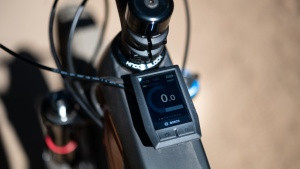 Trek Rail 9.7 handlebar controls
Trek Rail 9.7 handlebar controls
Image: Trek Rail 9.7’s top tube-mounted display and handlebar control unit for e-bike system management.
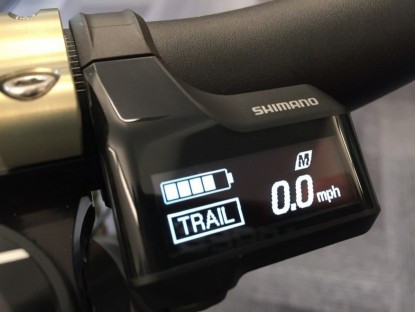 Shimano E7000 display on e-mountain bike
Shimano E7000 display on e-mountain bike
Image: Shimano E7000 display, compact and functional, used on several e-mountain bike models.
Conclusion: Choosing Your Best E-Mountain Bike
The e-mountain bike market offers many excellent options. Choosing the best e-mountain bike for your needs depends on your riding style, terrain, and budget. This comprehensive review helps navigate the options. We will continue updating this review as new e-bikes emerge.
For bike gear recommendations, see our reviews of bike gear, including mountain bike shoes, mountain bike helmets, and more.
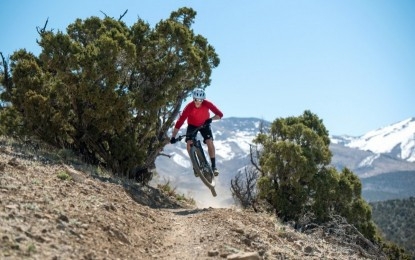 E-bikes are fun to ride, find the best one for you
E-bikes are fun to ride, find the best one for you
Image: E-bikes are incredibly fun to ride; find the best model to maximize your enjoyment and trail experience.
